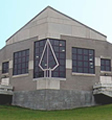|
Symbolism at the Onondaga Nation School
Architectural Design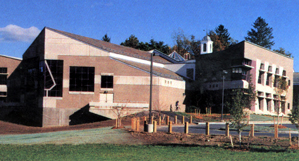
The architecture of the Onondaga Nation School addition makes use of materials, symbols and a design that focuses on the Onondaga and Iroquois culture and history. The design was planned and discussed with many members of the Onondaga community. Ideas and elements to be incorporated were presented and refined. Clearly the school was to be not only a school but also a cultural center. The key element at an early stage of design was the Cultural Gallery at the heart of the building. It was designed with a circular recessed floor representing Mother Earth with wooden arches enclosing the space around and overhead.
Materials
The materials used in the design of this school and cultural center were to be natural materials from the earth. The floors in the center and Cultural Gallery are a natural split, cleft slate. A number of other floors are wood. The Mother Earth turtle symbol is composed of strips of colored inlaid wood. The exterior of the building is a brick of an earth color, the roof materials is natural slate. |
|
The Cultural G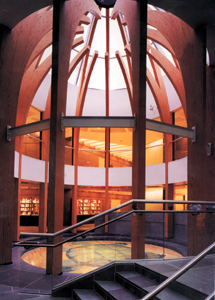 allery allery
The Cultural Gallery is at the heart of the new structure and it is made up of many symbols significant to the Onondagas. The overall shape is a circle representing the "circle of life". Mother Earth, the turtle, is inlaid in woods of different colors in the floor of the gallery. Ov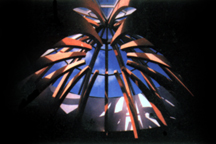 erhead is a sylight allowing views of the sky and clouds. Natural light floods into the gallery. There are thirteen wooden arches around the perimeter of the gallery which have an arch shape. The number 13 is significant because there are 13 lunar months in a year. The arch shape is representative of a natural tree arch and the shape of early longhouse's wooden roof structural members. On each arch is a circle in which the phases of the year are depicted. Surrounding the central circle are smaller clan symbols representing all the Onondaga clans. erhead is a sylight allowing views of the sky and clouds. Natural light floods into the gallery. There are thirteen wooden arches around the perimeter of the gallery which have an arch shape. The number 13 is significant because there are 13 lunar months in a year. The arch shape is representative of a natural tree arch and the shape of early longhouse's wooden roof structural members. On each arch is a circle in which the phases of the year are depicted. Surrounding the central circle are smaller clan symbols representing all the Onondaga clans.
Purple Color
Sections of the brick work, the windows, and doors are purple. The color purple is important to the Onondaga's as it one of colors of their wampum, purple and white. Wampum was first used by the Peacemaker and Hiawatha to help condole someone who has lost a loved one. Since then, wampum has been fashioned into belts to record important events or sanction treaties.
Light
Early in the design it was discussed that the introducation of as much natural light as possible into the building interior was very desirable. The large skylight at the Cultural Gallery allows light into the center of the structure. Light shelves on the classroom elevations and large windows reflect light deep into the interior of the rooms.
|
| The Phases of the Moon
In the Cultu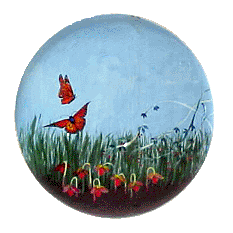 ral Gallery of the schoool stands thirteen wooden pillars, on which are painted the lunar calendar of the Haudenosaunee. Long before the modern day calendar the Haudenosaunee understood the passing of time by observing closely the subtle changes in the heavens above and the environment around them. Because of the great importance, special people called the "Faith Keepers" who are men and women are appointed within each of the clans. It is their duty to prepare for ceremonies and to observe carefully the signs and patterns of the seasons, animals, plant life, the moon, and the stars. They inform the people when to have the seasonal ceremonies as well as when to plant and harvest. ral Gallery of the schoool stands thirteen wooden pillars, on which are painted the lunar calendar of the Haudenosaunee. Long before the modern day calendar the Haudenosaunee understood the passing of time by observing closely the subtle changes in the heavens above and the environment around them. Because of the great importance, special people called the "Faith Keepers" who are men and women are appointed within each of the clans. It is their duty to prepare for ceremonies and to observe carefully the signs and patterns of the seasons, animals, plant life, the moon, and the stars. They inform the people when to have the seasonal ceremonies as well as when to plant and harvest.
The most significant time in the lunar calendar is during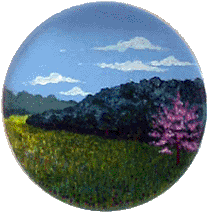 the mid-winter solstice. It is during the two moons of Dis uh and Dis go:nah that we hold the mid-winter cermonies that mark the end of the past year and the beginning of a new year. More importantly, it is understood that Grandmother Moon has a direct relationship to the females of all species living here on Mother Earth. the mid-winter solstice. It is during the two moons of Dis uh and Dis go:nah that we hold the mid-winter cermonies that mark the end of the past year and the beginning of a new year. More importantly, it is understood that Grandmother Moon has a direct relationship to the females of all species living here on Mother Earth.
|
The phases of the Moon are:
?
Disuh
Disgonah
Hisaatuh
Ganahdoha
Ganahdogonah
Ohyiaiha
Ohyiaihgonah
Saskeha
Saskahgonah
Kendenha
Kendenhgonah
Jotowehah
jotowehgonah
|
|

The Western Windows
The windows in the new gymnasium represents the Hiawatha Belt of the five original nations. This belt was created when The great peace came to the five origianl nations. The belt reads from east to west, following the path of the Peacemaker. First is the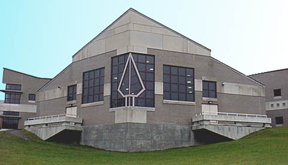 Mohawk (the Eastern Doorkeeper), the Oneida, the Onondaga (the Firekeepers), the Cayuga, and the Seneca (the Western Doorkeeprs). Mohawk (the Eastern Doorkeeper), the Oneida, the Onondaga (the Firekeepers), the Cayuga, and the Seneca (the Western Doorkeeprs).
The central symbol of a tree represents the Great Tree of Peace. The Peacemaker uprooted a great white pine tree which all of the Nations buried their weapons of war on the shores of Onondaga Lake. On top of this tree, he placed an eagle which keeps a watchful eye on the Haudenosaunee. If there are dangers to the peace, the eagle will send a warning to the people of the Haudenosaunee.
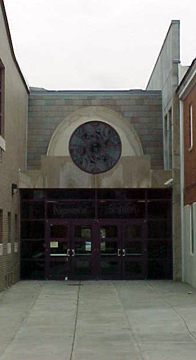
The Circle Windows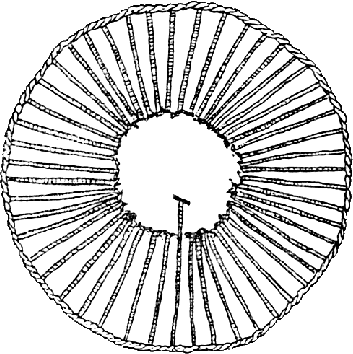
The design of the circle windows came from two Onondaga sources: One being "the Circle of Life", and the second being "The Circle Wampum".
The circle was simplified for the use as a window. The original Circle wampum belt consisted of fifty strings of wampum joined at one end of each string to the perimeter of a large circle made of two intertwined wampum strings. Each single string represents one of the original fifty chiefs of the Haudenosaunee. The belt symbolized the invitation of the Peacemaker, the architect of the Great Law of Peace, to each of the fifty chiefs. They were to join hands in a circle to recognize that they are all of equal rank and that they should never forget their responsibilities to the people. The two intertwined strings represent the Great Peace that was established amon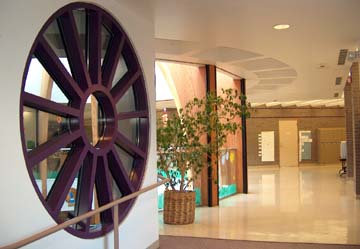 g the nations in the founding of the Great Law of Peace of the Haudenosaunee. g the nations in the founding of the Great Law of Peace of the Haudenosaunee.
|
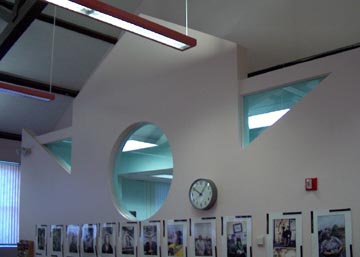
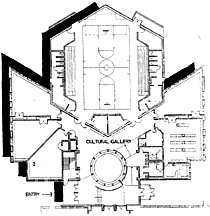
The Eagle Shape
The floor plan of the overall new building has a stylized shape of an eagle in flight.
The eagle is another symbol of significance of the Onondaga people. It is a symbol of strength and freedom. At the top of the Tree of Peace, the Peacemaker placed the eagle. In some representations the eagle is flying and circling over the top of the Tree of Peace. The eagle represents eternal vigilance, co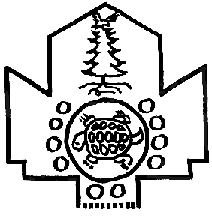 nstantly watching to warn the Haudenosaunee of impending dangers. From his vantage point the eagle would scream an alert to warn the people. nstantly watching to warn the Haudenosaunee of impending dangers. From his vantage point the eagle would scream an alert to warn the people.
|
|
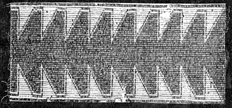 The Wing or Dust Fan Belt The Wing or Dust Fan Belt
The windows on the North and South classroom elevations were shaped to depict the Wing or Dust Fan Wampum Belt. This belt, which is one of the widest wampum belts known, measures 31 1/2" by 14 1/2" wide. It symbolizes an everlasting white pine tree which has growns so tall that all nations of the earth can see it. The nations were to take shelter beneath its branches once their weapons of war were buried beneath its roots. This Tree of Peace is particularly significant to the Onondagas as it was symbolically located within the Onondaga Nation.
The two-fold meaning of the Wing or Dust Fan Belt was; one, to protect the council or confederate chiefs from destructive thoughts and secondly, to shield their eyes from the dust that could impair their clear vision and understanding. At the final council be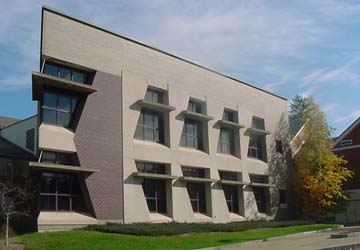 tween the Peacemaker and the chiefs, this was referred to as the last belt that confirmed the laws that had been established to bring about prosperity and happiness. Historically, the wing belt was kept at the Onondaga Nation and displayed whenever the League's constitution was recited. Purple beads form the ever growing pine tree which was also symbolic of the life of the confederacy. tween the Peacemaker and the chiefs, this was referred to as the last belt that confirmed the laws that had been established to bring about prosperity and happiness. Historically, the wing belt was kept at the Onondaga Nation and displayed whenever the League's constitution was recited. Purple beads form the ever growing pine tree which was also symbolic of the life of the confederacy.
|


